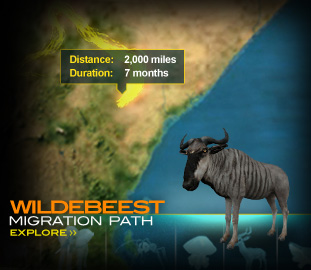Wildebeest
Animals — Wildebeest
INTERACTIVE WILDEBEEST PROFILE
WILDEBEEST (Connochaetes taurinus)
There are several subspecies of wildebeest. The variety that makes up the giant herds in the Serengeti is known as the white-bearded wildebeest, (Connachaetes taurinus mearnsi). Naturalist Richard Estes has described the wildebeest as a “keystone” species in the Serengeti, “one that has shaped and dominated its ecosystem, the seminar Savannas eastern and southern Africa, for probably more than a million years.” Over that time, the wildebeest has proven remarkably resilient, even against human-caused ecological disasters. In the late 1880s, for example, Indian cattle introduced into Africato to feed Italian colonial soldiers brought with them the rinderpest virus, which within a few years killed off vast numbers of wildebeest, in addition to 90 percent of the African continent’s buffalo and cattle. Nevertheless, the wildebeest rebounded, and by the 1960s, the virus had vanished from the Serengeti and the population there again numbered approximately 1.25 million.
Wildebeest, which live on short grasses, must move as the seasons change to find fresh grazing land and water. (They need to drink at least every other day, which limits them to grazing lands within roughly 6 to 10 miles of a water source.) Each year right after the calving season in January and February, they amass on the southeastern Serengeti plains and move west toward Lake Victoria, and then turn north into the Maasai Mara. As many as a quarter of them die during the journey, a long series of 12-hour forced marches in blistering heat in which they must run the gantlet of various predators. By the end of the dry season (roughly in November ), when they have exhausted the grazing lands, they return south to the Serengeti plains.
Wildebeest and their migratory pattern play an important role in the African ecosystem, because they crop the grasses and fertilize the ground with their droppings. They also provide a source of protein for predators.
MORE MIGRATIONS
-
Preserve their HabitatHelp conserve the natural landscapes of these migratory species.
-
Teacher ResourcesJoin the virtual assembly and access lesson plans specific to your area.
-
Nat Geo ExpeditionsTake a migration of your own with National Geographic Explorers.
-
Science Behind MigrationsHow do animals decide where to go, how long to stay, and when to leave?















